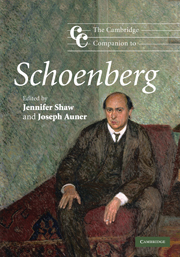Book contents
- Frontmatter
- 1 Introduction
- Part I Schoenberg's early years
- 2 Schoenberg's lieder
- 3 Schoenberg and the tradition of chamber music for strings
- 4 Two early Schoenberg songs: monotonality, multitonality, and schwebende Tonalität
- 5 Arnold Schoenberg and Richard Strauss
- Part II Schoenberg, modernism, and modernity
- Part III Schoenberg between the World Wars
- Part IV Schoenberg's American years
- Notes
- Select bibliography
- Index
4 - Two early Schoenberg songs: monotonality, multitonality, and schwebende Tonalität
from Part I - Schoenberg's early years
Published online by Cambridge University Press: 28 September 2011
- Frontmatter
- 1 Introduction
- Part I Schoenberg's early years
- 2 Schoenberg's lieder
- 3 Schoenberg and the tradition of chamber music for strings
- 4 Two early Schoenberg songs: monotonality, multitonality, and schwebende Tonalität
- 5 Arnold Schoenberg and Richard Strauss
- Part II Schoenberg, modernism, and modernity
- Part III Schoenberg between the World Wars
- Part IV Schoenberg's American years
- Notes
- Select bibliography
- Index
Summary
Arnold Schoenberg is so closely associated with the development of atonality and the twelve-tone system that his earlier tonal music, which is sizeable (Schoenberg was in his mid-thirties when he broke with tonality), tends to be considered primarily in relation to his later work. Even Schoenberg himself leaned toward this interpretation in his writings; and recent theoretical and analytical work has also seen the early work primarily in evolutionary terms, especially in relation to traditional tonality. This has produced valuable insights, but it has also downplayed the degree to which much of Schoenberg's tonal music maintains common-practice conventions.
The idea that Schoenberg's more advanced tonal compositions fundamentally undermine these conventions fits neatly with recent efforts to expand the general concept of tonality to include more varied and ambiguous types. But it has also fostered the development of analytical concepts that, however useful in themselves, do not necessarily apply to all chromatic music of the pre-atonal period. In this chapter I argue that one such concept, multitonality, leads to incorrect and exaggerated readings of some of Schoenberg's most original tonal compositions.
One of the leading figures in recent endeavors to enlarge the concept of tonality has been Robert Bailey, who in a number of articles has advanced the idea that late chromatic tonal works are no longer necessarily monotonal: rather than adhering to a single tonic, they are multitonal, having what he calls a “tonic complex” in which two or more keys compete for priority. Bailey's influence has been widespread and serves as the primary reference point for the most comprehensive publication to date delineating a theory of extended chromatic tonality.
- Type
- Chapter
- Information
- The Cambridge Companion to Schoenberg , pp. 53 - 67Publisher: Cambridge University PressPrint publication year: 2010
- 1
- Cited by



